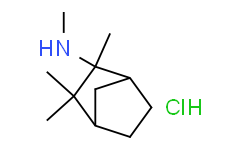| DC41803 |
α-Conotoxin MII
|
α-Conotoxin MII is a highly potent and selective competitive antagonist for α3β2 subunit-containing nicotinic receptors (IC50 = 0.5 - 3.5 nM at α3β2 expressed in Xenopus oocytes). Also potently blocks β3-containing neuronal nicotinic receptors. Displays > 200-fold selectivity for α3β2 over α2β2, α4β2 and α3β4. |
| DC29057 |
Mecamylamine hydrochloride
|
Mecamylamine hydrochloride is an orally active, nonselective, noncompetitive nAChR antagonist that can treat various neuropsychiatric disorders. Mecamylamine hydrochloride is originally used as a ganglionic blocker in treating hypertension. Mecamylamine hydrochloride can easily crosses the blood-brain barrier. |
| DC28701 |
nAChR agonist 1(DUN71755)
|
nAChR agonist 1 is a potent, brain-permeable, and orally efficacious positive allosteric modulator of α7 nicotinic acetylcholine receptor (α7 nAChR). nAChR agonist 1 has the EC50 of 0.32 µM in a Ca2+ mobilization assay (PNU-282987-induced, FLIPR based) in human IMR-32 neuroblastoma cells that endogenously express α7 nAChR. nAChR agonist 1 can be develpoped for the treatment of Alzheimer’s disease. |
| DC28187 |
Asoxime dichloride
|
Asoxime dichloride (HI-6) is an antagonist to acetylcholine receptors (AChRs) including the nicotinic receptor, α7 nAChR. Asoxime dichloride involves in modulating immunity response. Asoxime dichloride (HI-6) can be used as an antigen and improves vaccination efficacy in the nervous system. |
| DC28174 |
BNC210
|
BNC210 (H-Ile-Trp-OH; IW-2143) is a α7 nAChR negative allosteric modulator. BNC210 has potent activity in animal models of anxiety and depression. |
| DC11247 |
Nelonicline
|
Nelonicline (ABT-126) is a potent, selective α7 nicotinic receptor (nAChR) partial agonist for the treatment of cognitive impairment with schizophrenia.. |
| DC7987 |
Encenicline hydrochloride (EVP-6124)
|
Encenicline hydrochloride (EVP-6124 hydrochloride) is a novel partial agonist of α7 neuronal nicotinic acetylcholine receptors (nAChRs). |






















